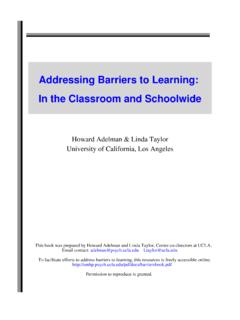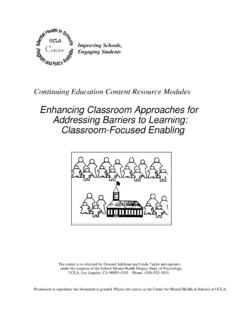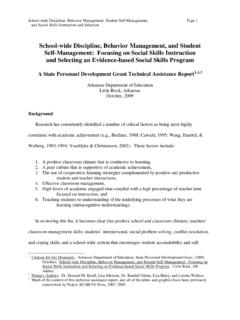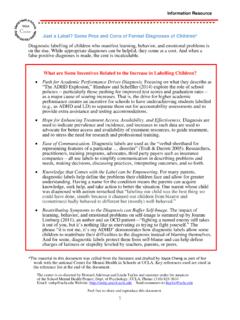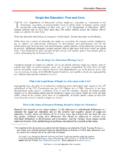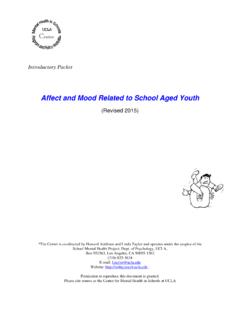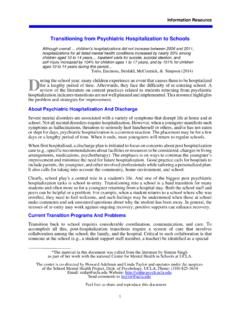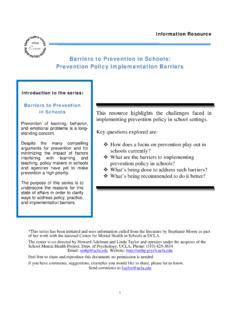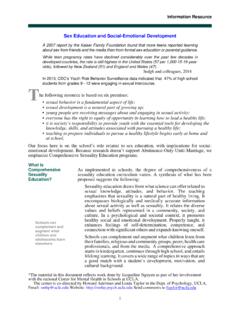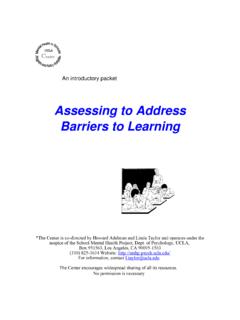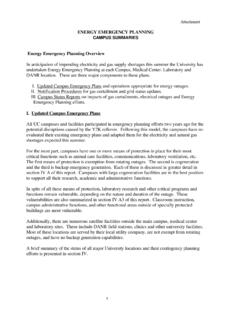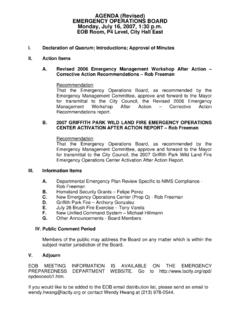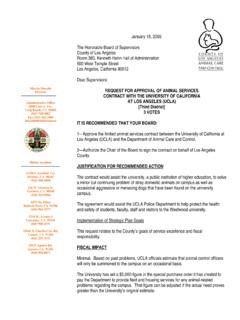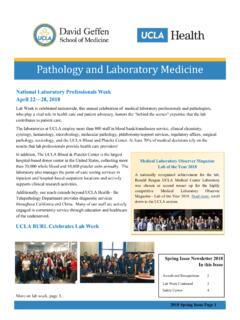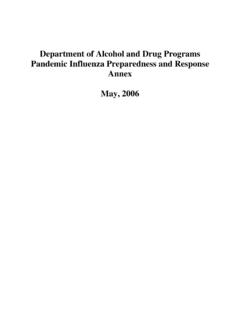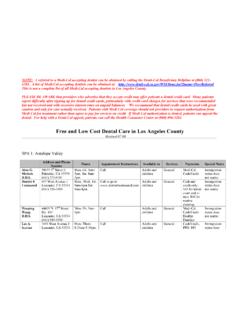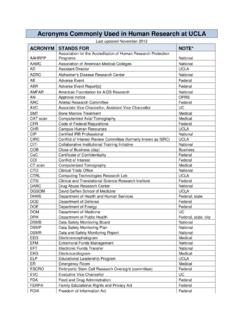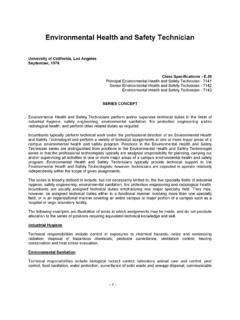Transcription of Intervention Focus in Dealing with Misbehavior
1 PRACTICE NOTESI ntervention Focus in Dealing with MisbehaviorUnfortunately, too many people see punishment as the only recourse in Dealing withmisbehavior. They use the most potent negative consequences available to them in a desperateeffort to control an individual and make it clear to others that the behavior is not of the frequency of student Misbehavior , teachers often feel they must deal with thebehavior problem before they can work on the matters of engagement and accommodation. This isespecially the case when deviant and devious behavior creates an unsafe environment. As a result, teachers and other school staff increasingly have adopted social control strategies. Theseinclude some discipline and classroom management practices that model behavior that fosters (ratherthan counters) development of negative values.
2 Exhibit 1 presents an overview of prevailingdiscipline schools, short of suspending the individual, punishment takes the form of a decision to dosomething to students that they do not want done. In addition, a demand for future complianceusually is made, along with threats of harsher punishment if compliance is not forthcoming. Thediscipline may be administered in ways that suggest the student is seen as an undesirable person. Asstudents get older, suspension increasingly comes into play. Indeed, suspension remains one of themost common disciplinary responses for the transgressions of secondary students. As with many emergency procedures, the benefits of using punishment may be offset by manynegative consequences. These include increased negative attitudes toward school and schoolpersonnel.
3 These attitudes often lead to more behavior problems, anti-social acts, and various mentalhealth problems. Disciplinary procedures also are associated with dropping out of school. Extremedisciplinary practices often constitute "pushout" strategies. A large literature points to the negative impact of harsh discipline. Most school guidelines for managing Misbehavior stress that discipline should be reasonable, fair,and nondenigrating ( , should be experienced by recipients as legitimate reactions that neitherdenigrate one's sense of worth nor reduce one's sense of autonomy). with this in mind, classroommanagement practices usually emphasize establishing and administering logical consequences. Suchan idea is generalized from situations where naturally occurring consequences are present, such astouching a hot stove causes a burn.
4 (See the Exhibit 2 for more on the topic of logicalconsequences.)Specific discipline practices ignore the broader picture that every classroom teacher must keep inmind. The immediate objective of stopping Misbehavior must be accomplished in ways thatmaximize the likelihood that the teacher can engage/re-engage the student in instruction and positivelearning. From a prevention viewpoint, few doubt that program improvements that engage and re-engagestudents can reduce behavior (and learning) problems significantly. Application of consequencesalso is recognized as an insufficient step in preventing future Misbehavior . Therefore, as outlinedin Exhibit 3, strategies for Dealing with Misbehavior should encompass interventions for preventing and anticipating Misbehavior reacting during Misbehavior following-up.
5 ( )Exhibit 1 Defining and Categorizing Discipline PracticesHistorically, the two mandates that have shaped much of current practice are: (1) schoolsmust teach self discipline to students; and (2) teachers must learn to use disciplinarypractices effectively to deal with Misbehavior . In 1987, Knoff offered three definitions of discipline as applied in schools: "(a) .. punitive Intervention ; (b) .. a means of suppressing or eliminatinginappropriate behavior, of teaching or reinforcing appropriate behavior, and ofredirecting potentially inappropriate behavior toward acceptable ends; and (c) .. aprocess of self control whereby the (potentially) misbehaving student appliestechniques that interrupt inappropriate behavior, and that replace it withacceptable behavior". In contrast to the first definition which specifies disciplineas punishment, Knoff viewed the other two as nonpunitive or as he called them"positive, best practices approaches.
6 " In 1982, Hyman, Flannagan, & Smith categorized models shaping disciplinary practices into5 groups: psychodynamic interpersonal models, behavioral models, sociological models,eclectic ecological models, and human potential modelsIn 1986, Wolfgang & Glickman grouped disciplinary practices in terms of a processoriented framework: relationship listening models confronting contracting models rules/rewards punishmentIn 1995, Bear categorized three goals of the practice with a secondary nod to processes,strategies and techniques used to reach the goals: preventive discipline models ( , models that stress classroom management,prosocial behavior, moral/character education, social problem solving, peermediation, affective education and communication models) corrective models ( , behavior management, Reality Therapy) treatment models ( , social skills training, aggression replacement training,parent management training, family therapy, behavior therapy) Exhibit 2 About Logical ConsequencesIn classrooms, little ambiguity may exist about the rules; unfortunately, the same often cannot besaid about "logical" penalties.
7 Even when the consequence for a particular rule infraction is specifiedahead of time, the logic may be more in the mind of the teacher than in the eyes of the students. Inthe recipient's view, any act of discipline may be experienced as punitive unreasonable, unfair,denigrating, disempowering. Basically, consequences involve depriving students of things they want and/or making themexperience something they don't want. Consequences take the form of (a) removal/deprivation ( ,loss of privileges, removal from an activity), (b) reprimands ( , public censure), (c) reparations( , to compensate for losses caused by Misbehavior ), and (d) recantations ( , apologies, plansfor avoiding future problems). For instance, teachers commonly deal with acting out behavior byremoving a student from an activity.
8 To the teacher, this step (often described as "time out") maybe a logical way to stop students from disrupting others by isolating them, or the logic may be thatthe students need a cooling off period. The reasoning is that (a) by misbehaving students show theydo not deserve the privilege of participating (assuming the students like the activity) and (b) the losswill lead to improved behavior in order to avoid future teachers have little difficulty explaining their reasons for using a consequence. However, ifthe intent really is for students to perceive consequences as logical and nondebilitating, logic callsfor determining whether the recipient sees the discipline as a legitimate response to , difficulties arise about how to administer consequences in ways that minimize negativeimpact on a student's perceptions of self.
9 Although the intent is to stress that the Misbehavior andits impact are bad, students too easily can experience the process as characterizing them as badpeople. Organized sports such as youth basketball and soccer offer a prototype of an established andaccepted set of consequences administered with recipient's perceptions given major these arenas, referees are able to use the rules and related criteria to identify inappropriate actsand apply penalties; moreover, they are expected to do so with positive concern for maintaining ayoungster's dignity and engendering respect for discipline is to be perceived as a logical consequence, steps must be taken to convey that aresponse is not a personally motivated act of power ( , an authoritarian action) and, indeed, is arational and socially agreed upon reaction.
10 Also, if the intent is long term reduction in futuremisbehavior, time must be taken to help students learn right from wrong, to respect others rights,and to accept responsibility. From a motivational perspective, logical consequences are based on understanding a student'sperceptions and are used in ways that minimize negative repercussions. To these ends, motivationtheory suggests (a) establishing publicly accepted consequences to increase the likelihood they areexperienced as socially just ( , reasonable, firm but fair) and (b) administering such consequencesin ways that allow students to maintain a sense of integrity, dignity, and autonomy. These ends arebest achieved under conditions where students are "empowered" ( , are involved in deciding howto make improvements and avoid future Misbehavior and have opportunities for positiveinvolvement and reputation building at school).
